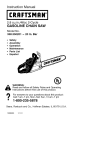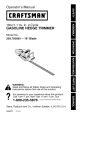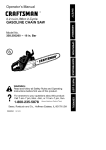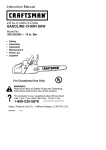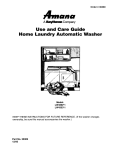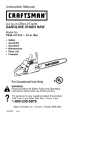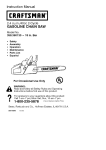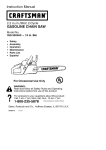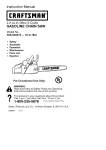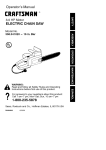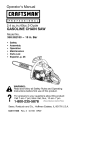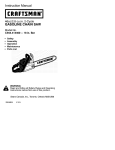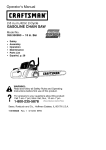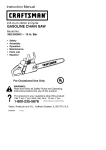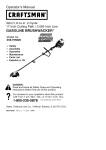Download Craftsman C944.411420 Instruction manual
Transcript
Instruction
Manual
I CRRFTSMRN°I
2.6 cu.in./42cc
GASOLINE
Model No.
C944.411420
•
2-Cycle
CHAIN
SAW
- 18 in. Bar
Safety
• Assembly
•
•
Operation
Maintenance
•
Parts List
•
Fran_ais
For Occasional
A
Use Only
C_._/
WARNING:
Read and follow all Safety Rules and Operating
Instructions
before first use of this product.
For answers
Call 7 am-7
to your questions about this product:
pm, Mon-Sat; Sun, 10 am-7 pm
1-800-235-5878
Sears Canada,
530088317
12/12/01
Inc., Toronto,
Ontario
M5B 2B8
Warranty Statement
Identification of Symbols
Safety Rules
Assembly
Operation
Maintenance
Service and Adjustments
2
2
3
7
8
14
17
Storage
Troubleshooting
Table
Emissions Statement
Parts List
French
Parts & Ordering
19
20
22
24
27
Back Cover
LIMITED ONE (1) YEAR WARRANTY FOR CRAFTSMAN _: GAS CHAIN SAW
For one (1) year from the date of purchase Sears Canada, Inc., will repair or
replace free of charge at Sears option parts which are defective as a result of
materials or workmanship.
COMMERCIAL OR RENTAL USE:
If this Gas Chain Saw is used for commercial application the warranty is void.
This warranty does NOT cover:
1. Expendable items which become worn during normal use, such as chain,
chain bar, starter rope, spark plugs, and filter.
2. Pro-delivery setup, installation of guide bar and chain.
3. Customer neglect; operating Chain Saw without proper fuel mixture or operating Chain Saw without lubrication.
Warranty service is available by returning the Gas Chain Saw to the nearest
Sears Service Centre/Department
in Canada. This warranty applies only while
this product is in use in Canada.
This warranty is in addition to any statutory warranty and does not exclude or limit
legal rights you may have but shall run concurrently with applicable provincial
legislation. Furthermore, some provinces do NOT allow limitation on how long an
implied warranty will last so the above limitations may not apply to you.
Sears Canada, Inc., Toronto, Ontario
M5B 2B8
i&I'V"TSS'""ce'e
I__
I'sezet
°°''ez
e
trongonneuse pout 6tre dangereuse! L'emploinegligeant ou impropre pout causer des blessures
graves ou m6mes fatales.
Portez toujours la protection
de I'oule appropri_e, la
protection des yeux et la
protection de t6te.
manuel
d'instructions
avant
d'utiliser
la
trongonneuse.
_
recul, sans frein de
chaTne, pour la combinaison
de mesur_e
barre et de
La valour
de
chaTnesur retiquette.
Emplo eztoujours
I'apparei,
adeu×
ma os.
AVERTISSEMENT!
II faudra eviter soigneusement
tout contact de la pointe de la barre avec n'importe quel objet; ce contact pout faire que la barre saute soudainement
vers le haut et vers I'arriere, ce que pourrait entraTner des
blessures graves.
,_ WARNI NG: Always disconnect
spark plug wire when making repairs except for carburetor adjustments. Because a chain saw is a high-speed
woodcutting tool, special safety precautions must be observed to reduce risk of
accidents. Careless or improper use of
this tool can cause serious injury.
PLAN AHEAD
• Restrict the use of your saw to adult
users who understand and can follow
the safety rules, precautions, and operating instructions found in this
manual.
• Wear protective gear. Always use
steel-toed safety footwear with nonslip soles; snug-fitting clothing;
heavy-duty, non-slip gloves; eye protection such as non-fogging, vented
goggles or face screen; an approved
safety hard hat; and sound barriers
(ear plugs or mufflers) to protect your
hearing. Regular users should have
hearing checked regularly as chain
saw noise can damage hearing.
Hearing
.... Safety Hat
Protection "_'- I'_'_ _
Eye
Snug
.... Protection
Fitting ......._
Heavy Duty
Clothing
Gloves
./
Safety
Shoes
_
Safety Chaps
• Secure hair above shoulder length.
Do not wear loose clothing or jewelry; they can get caught in moving
parts.
• Keep all parts of your body away
from the chain when the engine is
running.
• Keep children, bystanders, and animals at least 30 feet (10 meters)
away from the work area when starting and using the saw.
• Do not handle or operate a chain
saw when you are fatigued, ill, or upset, or if you have taken alcohol,
drugs, or medication. You must be in
good physical condition and mentally
alert. If you have any condition that
might be aggravated by strenuous
work, check with doctor before operating.
• Do not start cutting until you have a
clear work area, secure footing, and
especially if you are felling a tree, a
retreat path.
OPERATE YOUR SAW SAFELY
• Do not operate with one hand. Serious injury to the operator, helpers, or
bystanders may result from onehanded operation. A chain saw is intended for two-handed use.
• Operate the chain saw only in a wellventilated outdoor area.
• Do not operate saw from a ladder or
in a tree.
• Make sure the chain will not make
contact with any object while starting
the engine. Never try to start the saw
when the guide bar is in a cut.
• Do not put pressure on the saw, especially at the end of the cut. Doing
so can cause you to lose control
when the cut is completed.
• Stop engine before setting saw down.
• Hand carry saw only when engine is
stopped. Carry with muffler away
from body; guide bar & chain projecting behind you; guide bar preferably
covered with a scabbard.
• Do not operate a chain saw that is
damaged, improperly adjusted, or not
completely and securely assembled.
Always replace bar, chain, hand
guard, chain brake, or other parts immediately if they become damaged,
broken, or are otherwise removed.
MAINTAIN
YOUR
SAW IN GOOD
WORKING ORDER
• Have all chain saw service performed by a qualified service dealer
except the items listed in the MAINTENANCE section of this manual.
• Make certain the saw chain stops
moving when the throttle trigger is
released. For correction, refer to
CARBURETOR ADJUSTMENTS.
• Keep the handles dry, clean, and
free from oil or fuel mixture.
• Keep caps and fasteners securely
tightened.
• Nonconforming replacement components or the removal of safety devices
may cause damage to the unit and
possible injury to the operator or by-
standers.
UseonlyCraftsman
accessories
andreplacement
parts
asrecommended.
Never
modify
yoursaw.
• Maintain
chain
sawwithcare.
_tions
• Keep
unitsharp
andclean
forbetter
andsaferperformance.
• Follow
instructions
forlubricating
and
Clear The Working Area
changing
accessories.
A
• Check
fordamaged
parts.
Before
fur- _1_ WARNING: Avoid kickback which
theruseofthechain
saw,
aguard
or
result in serious injury. Kickback
other
partthatisdamaged
should
be can
is the backward, upward or sudden forcarefully
checked
todetermine
thatit
ward motion of the guide bar occurring
willoperate
properly
andperform
its
the saw chain near the upper tip
intended
function.
Check
foralignmentwhen
the guide bar contacts any object
ofmoving
parts,
binding
ofmoving ofsuch
a log or branch, or when the
parts,
breakage
ofparts,
mounting
and wood ascloses
in and pinches the saw
anyother
conditions
thatmayaffect
its chain in the cut.
a foreign
operation.
Aguard
orother
partthatis object in the woodContacting
can also result in
damaged
should
beproperly
repaired loss of chain saw control.
orreplaced
byaSears
Service
Centre Rotational Kickback can occur
unless
otherwise
indicated
elsewhere• when
the moving chain contacts an
intheinstruction
manual.
at the upper tip of the guide
• When
notinuse,chain
saws
should object
bar. This contact can cause the
bestored
inadry,highorlocked-up chain
to dig into the object, which
place
outofthereach
ofchildren.
stops the chain for an instant. The
• When
storing
saw,useascabbard
or result is a lightning fast, reverse
carrying
case.
reaction which kicks the guide bar up
HANDLE
FUEL
WITH
CAUTION
back toward the operator.
• Donotsmoke
while
handling
fuelor • and
Pinch-Kickback
can occur when the
while
operating
thesaw.
the wood closes in and pinches the
• Eliminate
allsources
ofsparks
or
moving saw chain in the cut along
flame
inareas
where
fuelismixed
or
the top of the guide bar and the saw
poured.
is suddenly stopped. This sud• Mixandpour
fuelinanoutdoor
area chain
den stopping of the chain results in a
anduseanapproved,
marked
conreversal of the chain force used to
tainer
forallfuelpurposes.
Wipe
up
cut wood and causes the saw to
allfuelspillsbefore
starting
saw.
move in the opposite direction of the
• Move
atleast10feet(3meters)
from chain
rotation. The saw is driven
fueling
sitebefore
starting.
straight back toward the operator.
• Turntheengine
offandletsawcool • Pull-In can occur when the moving
inanon-combustible
area,noton
contacts a foreign object in the
dryleaves,
straw,
paper,
etc.Slowly chain
wood in the cut along the bottom of
remove
fuelcapandrefuel
unit.
the guide bar and the saw chain is
• Store
theunitandfuelinacool,dry
suddenly stopped. This sudden stopwellventilated
space
where
fuelvaping pulls the saw forward and away
porscannot
reach
sparks
oropen
from the operator and could easily
flames
fromwater
heaters,
electric
cause the operator to lose control of
motors
orswitches,
furnaces,
etc.
the saw.
GUARD AGAINST KICKBACK
Follow all safety rules to help avoid
kickback and other forces which can
result in serious injury.
Kickback
Path
REDUCE THE CHANCE OF
KICKBACK
• Recognize that kickback can happen.
With a basic understanding of kickback, you can reduce the element of
surprise which contributes to accidents.
• Never let the moving chain contact
any object at the tip of the guide bar.
• Keep
working
areafreefromobstruc- control. Don't let go. Grip the rear
tionssuchasother
trees,
branches, handle with your right hand whether
rocks,
fences,
stumps,
etc.Eliminate you are right or left handed. Wrap the
oravoidanyobstruction
thatyour
fingers of your left hand over and
sawchain
couldhitwhile
cutting.
around the front handlebar, and your
• When
cutting
abranch,
donotletthe left thumb under the front handlebar.
guide
barcontact
another
branch
or
Keep your left arm straight with the
elbow locked.
other
objects
around
it.
• Keep
sawchain
sharp
andproperly • Position your left hand on the front
tensioned.
Aloose
ordullchain
can
handlebar so it is in a straight line
increase
thechance
ofkickback.
with your right hand on the rear hanFollow
manufacturer's
chain
sharp- dle when making bucking cuts.
ening
andmaintenance
instructions. Stand slightly to the left side of the
Check
tension
atregular
intervals, saw to keep your body from being in
butnever
withengine
running.
Make a direct line with the cutting chain.
surechain
brake
nutsaresecurely • Stand with your weight evenly balanced on both feet.
tightened.
• Do not overreach. You could be
• Begin
andcontinue
cutting
atfull
drawn or thrown off balance and lose
speed.
Ifthechain
ismoving
ata
control.
slower
speed,
thereisgreater
chance
ofkickback
occurring.
• Do not cut above shoulder height. It
• Useextreme
caution
when
reenter- is difficult to maintain control of saw
above shoulder height.
ingacut.
• Donotattempt
cutsstarting
withthe KICKBACK SAFETY FEATURES
tipofthebar(plunge
cuts).
• Watch
forshifting
logsorother
forces ,l_ WARNING: The following feathatcould
close
acutandpinch
or
tures are included on your saw to help
fallintochain.
reduce hazard of kickback; however,
• Usethespecified
Reduced-Kickback
such features will not totally eliminate
Guide
BarandLow-Kickback
Chain. this
danger. Do not rely only on safety
AvoidPinch-Kickback:
devices. Follow all safety rules to help
• Beextremely
aware
ofsituations
or
kickback and other forces which
obstructions
thatcancause
material avoid
can result in serious injury.
topinch
thetopoforotherwise
stop • Front Hand Guard: designed to rethechain.
duce the chance of your left hand
• Donotcutmore
thanonelogata
contacting the chain if your hand
time.
off the front handlebar.
• Donottwistsawasbariswithdrawn • slips
Position of front and rear handlebars:
fromanundercut
whenbucking.
designed with distance between hanAvoid Pull-In:
• Always begin cutting with the engine
at full speed and the saw housing
against wood.
• Use wedges made of plastic or
wood. Never use metal to hold the
cut open.
MAINTAIN CONTROL
Stand to the left of the saw
underside
of handlebar
Thumb on
/
\I
a_s_
dles and "in-line" with each other. The
spread and "in-line" position of the
hands provided by this design work
together to give balance and resistance in controlling the pivot of the
saw back toward the operator if kickback occurs.
• Reduced-Kickback
Guide Bar: designed with a small radius tip which
reduces the size of the kickback
danger zone. This type bar has been
demonstrated to significantly reduce
the number and seriousness of kickbacks.
\\
Elbow
locked
_,_&
Never reverse hand positions
• A good, firm grip on the saw with
both hands will help you maintain
Small Radius
Tip GuideBa//_,
Large
Radius
Tip
Guide
Bar [
• Low-Kickback
Chain:
hasmetkickbackperformance
requirements
when
tested
onarepresentative
sample
of
chain
saws
below
3.8cubic
inchdisplacement.
Low-Kickback
Chain
Contoured
Depth
Gauge
............Elongated
Guard
Link
force
and
allows
wood
togradually
deflects
kickback
ride
into
Cutter
CHAIN
BRAKE
&CKAANGLE
• Chain Brake: designed to stop the
chain in the event of kickback.
,_ILWARNING:
WE DO NOT REPRESENT AND YOU SHOULD NOT ASSUME THAT THE CHAIN BRAKE WILL
PROTECT YOU IN THE EVENT OF A KICKBACK. Kickback is a lightning fast action
which throws the bar and rotating chain
back and up toward the operator. Kickback can be caused by allowing contact
of the bar tip in the danger zone with any
hard object.
Kickback
can also be
caused by pinching the saw chain along
the top ofthe guide bar. This action may
push the guide bar rapidly back toward
the operator. Either ofthese events may
cause you to lose control of the saw
which could result in serious injury or
even death. DO NOT RELYUPON ANYOF
THE DEVICES BUILT INTO YOUR SAW.
YOU SHOULD USE THE SAW PROPERLY
AND CAREFULLY TO AVOID KICKBACK.
Reduced-kickback
guide bars and lowkickback saw chains reduce the chance
and magnitude of kickback and are recommended.
Your saw has a low kickback chain and bar as original equipment. Repairs on a chain brake should
be made by an authorized Sears Service
Computed
Centre. Take your unit to the place of purchase or to your nearest Sears Service
Centre.
• Tip contact in some cases may cause
a lightning fast reverse REACTION,
kicking guide bar up and back toward
operator.
• Pinching the saw chain along the top
of the guide bar may push the guide
bar rapidly back toward the operator.
• Either of these reactions may cause
you to lose control of the saw which
could result in serious injury. Do not
rely exclusively upon safety devices
built into your saw.
,_ WARNING:
Computed kickback
angle (CKA) listed on your saw and
listed in the CKA table below represents
angle of kickback your bar and chain
combinations will have when tested in
accordance with CSA (Canadian Standards Association) standards. When
purchasing replacement bar and chain,
considerations should be given to the
lower CKA values. Lower CKA values
represent safer angles to the user, higher values indicate more angle and higher kick energies. Computed angle represented indicates total energy and angle
associated without activation of the
chain brake during kickback. In all cases
lower CKA values represent a safer operating environment for the user.
The following guide bar and chain combinations meet kickback requirements
of CSA Z62.1 & Z62.3 when used on
saws listed in this manual. Use of bar
and chain combinations
other than
those listed is not recommended
and
may not meet the CKA requirements per
standard.
kickback
MODEL
C944.411420
angle (CKA) Table
BAR
P/N
Lenqth
CHAIN P/N
71-36598
18"
71-3619
SAFETY NOTICE: Exposure to vibrations through prolonged use of gasoline
powered hand tools could cause blood
vessel or nerve damage in the fingers,
hands, and joints of people prone to
circulation disorders or abnormal swelling. Prolonged use in cold weather has
been linked to blood vessel damage in
otherwise healthy people. If symptoms
occur such as numbness, pain, loss of
CKA without
chain brake
14"
strength, change in skin color or texture,
or loss of feeling in the fingers, hands, or
joints, discontinue the use of this tool
and seek medical attention. An anti-vibration system does not guarantee the
avoidance of these problems. Users
who operate power tools on a continual
and regular basis must closely monitor
their physical condition and the condition
of this tool.
SPARK
ARRESTING
SCREEN:
Your suchregulations
exist,
youarelegally
sawisequipped
withatemperature responsible
formaintaining
theoperatlimiting
muffler
andspark
arresting ingcondition
ofthese
parts.
Failure
to
ofthelaw.Refer
to
screen
which
meets
therequirementsdosoisaviolation
ofCalifornia
Codes
4442and4443.
All CUSTOMER
RESPONSIBILITIES
TABLE
U.S.
forest
landandthestates
ofCali- intheMAINTENANCE
section.
fornia,
Idaho,
Maine,
Minnesota,
New STANDARDS
Jersey,
Oregon,
andWashington
reZ62,1-1995
"Chain
Saws
- Ocquirebylawthatmany
internal
com- CSA
cupational
Health
andSafety"
bustion
engines
beequipped
witha
"Chain
SawKickspark
arresting
screen.
Ifyouoperate CSAZ62,3-1996
achain
sawinastateorlocale
where backOccupational
Health
andSafety"
CARTON
CONTENTS
Check
carton
contents
against
thefollowing
list.
Model C944,411420
• Chain Saw (fully assembled)
• Bar tool
• 2-cycle engine oil (bar oil not included)
Examine parts for damage. Do not use
damaged parts.
If you need assistance or find that parts
are missing or damaged, please call
1-800-235-5878.
NOTE: It is normal to hear the fuel filter
rattle in an empty fuel tank.
Your unit has been factory tested and
the carburetor precisely adjusted. As a
result you may smell gasoline or find a
drop of oil/fuel residue on the muffler
when you unpack the unit.
ASSEMBLY
Your saw is fully assembled;
assembly is necessary.
no
KNOW
YOUR
SAW
READ THIS INSTRUCTION MANUAL AND SAFETY RULES BEFORE OPERATING YOUR
CHAIN SAW. Compare the illustrations with your unit to familiarize yourself with the
location of the various controls and adjustments. Save this manual for future reference.
Chain
Adjustment
Tool
Front Handle
/4"_ _€/"
Hand Guard_r_
I U,
Rear
Throttle
Cylinder Cover
....
, /_
Lockout
....
,
/
rk[._/
_
_-/I
_
__
Chain
Bar Oil Fill Cap
J
[kRI
Housing
Starter Rope
ON/STOP
_f'-_ _'_
pr: mber
Fuel Mix Fill Cap
_A/
_
_"_o
,
!
_/_ Jn g
__--_r_
_\q
Throttle
Trigger
Switch
Choke
Knob
Bar
Ch_ntsBrake
Chain
t
Brake Chain Catcher
ON/STOP SWITCH
The ON/STOP SWITCH is used to stop
the engine.
THROTTLE TRIGGER
The THROTTLE TRIGGER controls engine speed.
THROTTLE
LOCK-OUT
The THROTTLE LOCK-OUT must be
pressed before you can squeeze the
throttle trigger. This feature prevents
you from accidentally squeezing the
trigger.
CHOKE/FAST
IDLE LEVER
The choke and fast idle are set by pulling the CHOKE/FAST IDLE LEVER out
fully for cold or refueled starting. The
choke provides additional fuel to the
engine during cold starting.
PRIMER BULB
The PRIMER BULB circulates fuel to the
carburetor to provide quicker starting.
iv°e_
G uid,_JBar _"
Splocket
CHAIN BRAKE
The CHAIN BRAKE is a device designed to stop the chain if kickback occurs. The chain brake activates automatically in the event of kickback. The
chain brake activates manually if the
front hand guard is pushed forward.
The chain brake is disengaged by pulling the front hand guard back toward
the front handle as far as possible.
CHAIN TENSION
It is normal for a new chain to stretch
during first 30 minutes of operation. You
should check your chain tension frequently. See CHAIN TENSION under the
SERVICE AND ADJUSTMENTS section.
,_WARNING:
Muffler is very hot
during and after use. Do not touch the
muffler or allow combustible material
such as dry grass or fuel to do so.
BEFORE
STARTING
ENGINE
formation
ofacids
during
storage.
Acidic
gascandamage
thefuelsystem
ofan
_WARNING:Besuretoread
the
engine
while
instorage.
fuelhandling
information
inthesafety Toavoid
engine
problems,
thefuelsysrules
section
ofthismanual
before
you temshould
beemptied
before
storage
begin.
Ifyoudonotunderstand
the
for30daysorlonger.
Drain
thegas
fuelhandling
information
donotattank,
start
theengine
andletitrununtil
tempt
tofuelyourunit.Seek
helpfrom thefuellinesandcarburetor
areempty.
someone
thatdoesunderstand
thein- Usefresh
fuelnextseason.
SeeSTORformation
orcallthecustomer
assis- AGE
instructions
foradditional
informatance
helplineat1-800-235-5878. tion.
Never
useengine
orcarburetor
cleanGUIDE
BARANDCHAIN
OIL
inthefueltankorpermaThechain
oilerprovides
continuous erproducts
damage
mayoccur.
lubrication
tothechainandguide
bar. nent
theSTORAGE
section
foradditionBesuretofillthebaroiltankwhen
you See
fillthefueltank(Capacity
=6.8fl.oz.). alinformation.
BRAKE
Formaximum
guide
barandchain
life, CHAIN
chainbrake
isdisengaged
by
werecommend
youuseCraftsman Ensure
pulling
thefronthand
guard
backtochain
sawbaroil.IfCraftsman
baroil
thefronthandle
asfarasposisnotavailable,
youmayuseagood ward
Thechainbrake
must
bedisengrade
SAE30oiluntilyouareableto sible.
gaged
before
cutting
with
the
saw.
obtain
Craftsman
brand.
Theoiloutput
isautomatically
metered
during
opera- _ikWARNING:
Thechainmust
not
tion.Your
sawwilluseapproximatelymove
w
hen
t
heengine
runs
a
tidle
onetankofbaroilforevery
tankoffuel
Ifthechainmoves
atidle
mix.Always
fillthebaroiltankwhen speed.
speed
r
efer
toCARBURETOR
ADJUSTyoufillthefueltank.
MENT
within
thismanual.
Avoid
conFUELING
ENGINE
tactwiththemuffler.
Ahotmuffler
can
cause
serious
burns.
_WARNIN_I:Remove
fuelcap
STOPPING
YOUR
ENGINE
slowly
whenrefueling.
• Move ON/STOP switch to the STOP
Thisengine
iscertified
tooperate
on
position.
unleaded
gasoline.
Before
operation,
ON/STOP SWITCH
gasoline
must
bemixed
withagood
quality
synthetic
2-cycle
air-cooled
enoN
gineoil.Werecommend
Craftsman
STARTING
YOUR ENGINE
brand
synthetic
oil.Mixgasoline
and
oilataratioof40:1.A40:1ratioisob- • To start the engine, hold the saw
tained
bymixing
95mlofoilwith4
firmly on the ground as illustrated.
litres
ofunleaded
gasoline.
Included Make sure the chain is free to turn
withthissawisa95mlcontainer
of
without contacting any object.
Craftsman
brand
oil.Pour
theentire
Starter Rope Handle
contents
ofthiscontainer
into4litres
of
gasoline
toachieve
theproper
fuel
mixture.
DONOT
USE
automotive
oilor
boatoil.These
oilswillcause
engine
damage.
When
mixing
fuelfollow
the
instructions
printed
onthecontainer.
Once
oilisadded
tothegasoline,
shake
container
momentarily
toassure
thatthefuelisthoroughly
mixed.
Alwaysreadandfollow
thesafety
rules
relating
tofuelbefore
fueling
yourunit. Important points to remember
IMPORTANT
When pulling the starter rope, do not
Experience
indicates
thatalcohol
use the full extent of the rope as this
blended
fuels(called
gasohol
orusing can cause the rope to break. Do not
ethanol
ormethanol)
canattract
mois- let starter rope snap back. Hold the
turewhich
leads
toseparation
and
handle and let the rope rewind slowly.
9
Forcoldweather
starting,
starttheunit
atFULL
CHOKE;
allow
theengine
to
warm
upbefore
squeezing
thethrottle
trigger.
NOTE:
DONOT
cutmaterial
withthe
choke/fast
idlelever
attheFULL
CHOKE
position.
STARTING
A COLD ENGINE (or a
warm engine after running out of
fuel)
NOTE: In the following steps, when
the choke/fast idle lever is pulled out to
the full extent, the correct throttle setting for starting is set automatically.
1. Move ON/STOP switch to ON position.
2. Pull choke/fast idle lever out to the
full extent.
3. Slowly press primer bulb 6 times.
4. Pull the starter rope quickly with
your right hand 5 times. Then, proceed to the next step.
NOTE: If the engine sounds as if it is
trying to start before the 5th pull, stop
pulling and immediately proceed to the
next step.
5. Push the choke/fast idle lever in
completely (to the OFF CHOKE
position).
6. Pull the starter rope quickly with your
right hand until the engine starts.
7. Allow the engine to run for approximately 5 seconds. Then, squeeze
and release throttle trigger to allow
engine to return to idle speed.
Switch
-_-q?C'_v--,_
-
_
,,_/_ej
Primerr2_V%/'F
Bulb
II
/
Choke!Fast Idle
Lever
4.
Pull the starter rope quickly with
your right hand until the engine
starts.
5. Squeeze and release throttle trigger, allowing engine to idle.
DIFFICULT STARTING (or starting a
flooded engine)
The engine may be flooded if it has not
started after 10 pulls.
Flooded engines can be cleared of excess fuel by following the warm engine
starting procedure listed above. Insure
the ON/STOP switch is in the ON position.
Starting could require many pulls depending on how badly the unit is
flooded. If engine still fails to start, refer
to the TROUBLESHOOTING TABLE or
call 1-800-235-5878.
CHAIN
BRAKE
,_I, WARNING:
If the
brake band
is
worn too thin it may break when the chain
brake is triggered. With a broken brake
band, the chain brake will not stop the
chain. The chain brake must be replaced
if any part is worn to less than 1/32" thick.
Repairs on a chain brake should be made
by your Sears Service Centre. Take your
unit to the place of purchase or to the
nearest Sears Service Centre.
• This saw is equipped with a chain
brake. The brake is designed to stop
the chain if kickback occurs.
• The inertia-activated chain brake is activated if the front hand guard is pushed
forward, either manually (by hand) or
automatically (by sudden movement).
• If the brake is already activated, it is
disengaged
by pulling the front hand
guard back toward the front handle as
far as possible.
• When cutting with the saw, the chain
brake must be disengaged.
Disengaged
CHOKE/FAST IDLE LEVER
L
(SIDEVlEW)
Chok_ /
Fast Idle Lever
_
";
OFF
FULL
STARTING A WARM ENGINE
1. Move ON/STOP switch to ON position.
2. Pull the choke/fast idle lever out to
the full extent, then push the lever
back in completely (to the OFF
CHOKE position).
3. Slowly press primer bulb 6 times.
Braking function
control
CAUTION:
The chain brake must be
checked several times daily. The engine
must be running when performing
this
procedure.
This is the only instance
when the saw should be placed on the
ground with the engine running.
Place the saw on firm ground. Grip the
rear handle with your right hand and the
front handle with your left hand. Apply full
throttle by fully depressing the throttle trig10
ger.Activate
thechain
brake
byturning • To avoid losing control when cut is
yourleftwristagainst
thehandguard complete, do not put pressure on
saw at end of cut.
without
releasing
yourgriparound
the
fronthandle.
Thechainshould
stopim- • Stop engine before setting saw down.
mediately.
TREE FELLING TECHNIQUES
Inertia activating function control
_ILWARNING:
When performing the
following procedure, the engine must
be turned off.
Grip the rear handle with your right hand
and the front handle with your left hand.
Hold the chain saw approximately
14"
(35 cm) above a stump or other wooden surface. Release your grip on the
front handle and use the weight of the
saw to let the tip of the guide bar fall
forward and contact the stump. When
the tip of the bar hits the stump, the
brake should activate.
OPERATING TIPS
• Check chain tension before first use
and after 1 minute of operation. See
CHAIN TENSION in the MAINTENANCE
section.
• Cut wood only. Do not cut metal,
plastics, masonry, non-wood building
materials, etc.
• Stop the saw if the chain strikes a
foreign object. Inspect the saw and
repair parts as necessary.
• Keep the chain out of dirt and sand.
Even a small amount of dirt will
quickly dull a chain and increase the
possibility of kickback.
• Practice cutting a few small logs using the following steps. This will help
you get the "feel" of using your saw
before you begin a major sawing operation.
• Squeeze the throttle trigger and allow the engine to reach full speed
before cutting.
• Begin cutting with the saw frame
against the log.
• Keep the engine at full speed the
entire time you are cutting.
• Allow the chain to cut for you. Exert
only light downward pressure.
• Release the throttle trigger as soon
as the cut is completed, allowing
the engine to idle. If you run the
saw at full throttle without a cutting
load, unnecessary wear can occur.
'_WARNING:
dead branches
Check for broken or
which can fall while
cutting causing serious injury. Do not
cut near buildings or electrical wires if
you do not know the direction of tree
fall, nor cut at night since you will not
be able to see well, nor during bad
weather such as rain, snow, or strong
winds, etc.
• Carefully plan your sawing operation
in advance.
• Clear the work area. You need a
clear area all around the tree so you
can have secure footing.
• The chain saw operator should keep
on the uphill side of the terrain as the
tree is likely to roll or slide downhill
after it is felled.
• Study the natural conditions that can
cause the tree to fall in a particular
direction. These conditions include:
• The wind direction and speed.
• The lean ofthe tree. The lean of a
tree might not be apparent due to
uneven or sloping terrain. Use a
plumb or level to determine the direction of tree lean.
• Weight and branches on one side.
• Surrounding trees and obstacles.
• Look for decay and rot. If the trunk is
rotted, it can snap and fall toward the
operator.
• Make sure there is enough room for
the tree to fall. Maintain a distance of
2-1/2 tree lengths from the nearest
person or other objects. Engine
noise can drown out a warning call.
• Remove dirt, stones, loose bark,
nails, staples, and wire from the tree
where cuts are to be made.
_"_e&-e
t
{
45" /_
"_/,e¢
11
Plan a clear retreat path
_--_-
Direction of Fall
FELLING
LARGE
TREES
(6inches
indiameter
orlarger)
Thenotch
method
isusedtofelllarge
trees.
Anotch
iscutonthesideofthe
treeinthedesired
direction
offall.After
afelling
cutismade
ontheopposite
sideoftree,
thetreewilltendtofallin
thedirection
ofthenotch.
NOTE:
Iftreehaslarge
buttress
roots,
remove
thembefore
making
thenotch.
Ifusing
sawtoremove
buttress
roots,
keep
sawchain
fromcontacting
ground
toprevent
dulling
ofthechain.
NOTCH
CUT
ANDFELLING
TREE
• Make
notch
cutbycutting
thetopof
thenotch
first.Cutthrough
1/3ofthe
diameter
ofthetree.Nextcomplete
thenotch
bycutting
thebottom.
See
illustration.
Once
thenotch
iscut,remove
thewedge
ofwoodfromtree.
First
cut
Notch_._
2-
Felling cut here
/
._..
2"
Soco do
j \ .7
• After removing the wood, make the
felling cut on the opposite side of the
notch. This is done by making a cut
about two inches higher than the
Centre of the notch. This will leave
enough uncut wood between the felling cut and the notch to form a hinge.
This hinge will help prevent the tree
from falling in the wrong direction.
Hinge holds tree on
stump and helps
control fall
Opening of
felling cut
Closing
of notch
.......v
NOTE: Before felling cut is complete,
use wedges to open the cut when
necessary to control the direction of
fall. To avoid kickback and chain
damage, use wood or plastic wedges,
but never steel or iron wedges.
• Be alert to signs that the tree is
ready to fall: cracking sounds, widening of the felling cut, or movement in
the upper branches.
• As tree starts to fall, stop saw, put it
down, and get away quickly on your
planned retreat path.
• DO NOT use your saw to cut down a
partially fallen tree. Be extremely
cautious with partially fallen trees
that may be poorly supported. When
a tree doesn't fall completely, set the
saw aside and pull down the tree
with a cable winch, block and tackle,
or tractor.
CUTTING A FALLEN TREE
(BUCKING)
Bucking is the term used for cutting a
fallen tree to the desired log size.
_ik WARNING:
Do not stand on the
log being cut. Any portion can roll
causing loss of footing and control. Do
not stand downhill of the log being cut.
IMPORTANT POINTS
• Cut only one log at a time.
• Cut shattered wood very carefully;
sharp pieces of wood could be flung
toward operator.
• Use a sawhorse to cut small logs.
Never allow another person to hold
the log while cutting and never hold
the log with your leg or foot.
• Do not cut in an area where logs,
limbs, and roots are tangled. Drag logs
into a clear area before cutting them.
BUCKING TECHNIQUES
WARNING:
If saw becomes
pinched or hung in a log, don't try to
force it out. You can lose control of the
saw resulting in injury and/or damage
to the saw. Stop the saw, drive a
wedge of plastic or wood into the cut
until the saw can be removed easily.
Restart saw and carefully reenter the
cut. Do not use a metal wedge. Do not
attempt to restart your saw when it is
pinched or hung in a log.
Use a wedge to remove pinched saw
Turn saw OFF and use a plastic or
wooden wedge to force cut open.
Overcutting
begins on the top side of
the log with the bottom of the saw
against the log. When overcutting use
light downward pressure.
12
Overcutting
Undercutting
_. 1st Cut
.,_r -j
Undercutting
involves cutting on the
underside
of the log with top of saw
against the log. When undercutting
use light upward pressure.
Hold saw
firmly and maintain control. The saw
will tend to push back toward you.
Using asupport _nd
Cut
,_WARNING:
Never turn saw upside down to undercut. The saw cannot be controlled in this position.
1st Cut-
Always make your first cut on the
compression
side of the log. The compression side of the log is where the
pressure of the log's weight is concentrated.
L
2 nd
Cut ....
First cut on compression side of log
LIMBING
AND PRUNING
,_ik WARNING:
Second cut
First cut on compression side of log
BUCKING WITHOUT A SUPPORT
• Overcut through 1/3 of the diameter
of the log.
• Roll the log over and finish with a
second overcut.
• Watch for logs with a compresion
side. See illustrations for cutting logs
with a compression side.
BUCKING USING A LOG OR
SUPPORT STAND
• Remember your first cut is always on
the compression side of the log. (Refer to the illustrations below for your
first and second cut).
• Your first cut should extend 1/3 of the
diameter of the log.
• Finish with your second cut.
Using a log for support
2 nd
%
,
Be alert for and
guard against kickback. Do not allow
the moving chain to contact any other
branches or objects at the nose of the
guide bar when limbing or pruning. Allowing such contact can result in serious injury.
Cut.
1 st Cut
,_ik WARNING:
Never climb into a
tree to limb or prune. Do not stand on
ladders, platforms, a log, or in any position which can cause you to lose
your balance or control of the saw.
IMPORTANT POINTS
• Watch out for springpoles.
Springpoles are small size limbs
which can whip toward you, or pull
you off balance. Use extreme caution when cutting small size limbs.
• Be alert for springback. Watch out for
branches that are bent or under
pressure. Avoid being struck by the
branch or the saw when the tension
in the wood fibers is released.
• Frequently clear branches out of the
way to avoid tripping over them.
LIMBING
• Limb a tree only after it is cut down.
• Leave the larger limbs underneath
the felled tree to support the tree as
you work.
• Start at the base of the felled tree
and work toward the top, cutting
branches and limbs. Remove small
limbs with one cut.
13
• Keep
thetreebetween
youandthe • Next make a second cut an overcut
chain.
all the way through the limb,
• Remove
larger,
supporting
branches • Finish the pruning operation by using
withthecutting
techniques
described an overcut so that the stump of the
inBUCKING
WITHOUT
ASUPPORT. limb )rotrudes 1 to 2 inches from the
trunk of the tree.
• Always
useanovercut
tocutsmall
andfreely
hanging
limbs.
Undercuttingcouldcause
limbs
tofalland
pinch
thesaw.
Sect_ d cut
PRUNING
,_/k WARNING:
Limit pruning to limbs
shoulder height or below. Do not cut if
branches are higher than your shoulder. Get a professional to do the job.
• Make your first cut 1/3 of the way
through the bottom of the limb. This
cut will make the limb sag so that it
falls easily on the second cut.
CUSTOMER
Sto &y
/_
I
3rd out 1 to 2 in.
\
from trunk of tree
RESPONSIBILITIES
_kWARNING:
Disconnect the spark plug before
except for carburetor adjustments.
Fill in dates as you complete
regular service
Check for damaged/worn
Before
Use
After
Use
ii
parts
performing
maintenance
i
Every Every
5 hrs. 25 hrs. Yearly i Service
Dates
Check for loose fasteners/parts
Check chain tension
Check chain sharpness
Check guide bar
Check fuel mixture level
Check guide bar and chain oil
Inspect
i
i
i
i
and clean unit & decals
i
Check chain brake
Clean guide bar groove
Clean air filter
Clean/inspect
muffler and spark
arresting screen
Replace
i
spark plug and fuel filter
GENERAL RECOMMENDATIONS
The warranty on this unit does not cover items that have been subjected to
operator abuse or negligence. To receive full value from the warranty, the
operator must maintain unit as instructed in this manual. Various adjustments
will need to be made periodically to
properly maintain your unit.
• Once a year, replace the spark plug,
air filter element, and check guide bar
and chain for wear. A new spark plug
and air filter element assures proper
air-fuel mixture and helps your engine
run better and last longer.
14
CHECK
FOR
DAMAGED
OR
3.
WORN
PARTS
Contact
Sears
Service
Centre
forreplacement
ofdamaged
orwornparts.
NOTE:
Itisnormal
forasmall
amount
ofoiltoappear
under
thesawafterenginestops.
Donotconfuse
thiswitha
leaking
oiltank.
• ON/STOP
Switch
- Ensure
ON/STOP
switch
functions
properly
bymoving
theswitch
totheSTOP
position.
4.
Make
sureengine
stops;
thenrestart
engine
andcontinue.
• Fuel
Tank- Donotusesawiffuel
5.
tankshows
signs
ofdamage
or
leaks.
• OilTank- Donotusesawifoiltank
6.
shows
signs
ofdamage
orleaks.
CHECK
FOR
LOOSE
FASTENERS
ANDPARTS
• Chain
Brake
Nuts
• Chain
• Muffler
• Cylinder
Shield
• AirFilter
• Handle
Screws
• Vibration
Mounts
7.
• Starter
Housing
• Front
Hand
Guard
CHECK
CHAIN
TENSION
8.
,_ WARNING:
Wear protective
gloves when handling chain. The
chain is sharp and can cut you even
when it is not moving.
Chain tension is very important.
Chains stretch during use. This is especially true during the first few times
you use your saw. Always check
chain tension each time you use and
refuel your saw.
1. Use the screwdriver end of the
chain adjustment tool (bar tool) to
move chain around guide bar to
ensure kinks do not exist. The
chain should rotate freely.
Bar
/_
Chain Brake
Nuts
2.
Adjusting
Screw
Chain Adjustment
Tool
(Bar Tool)
Loosen chain brake nuts until they
are finger tight against the chain
brake.
9.
Turn adjusting screw clockwise until chain solidly contacts bottom of
guide bar rail.
Using bar tool, roll chain around
guide bar to ensure all links are in
bar groove.
Lift up tip of guide bar to check for
sag. Release tip of guide bar, then
turn adjusting screw until sag does
not exist.
While lifting tip of guide bar, tighten
chain brake nuts securely with the
bar tool.
_
Cht_n Brake_
_.
_
Use the screwdriver end of the bar
tool to move chain around guide
bar.
If chain does not rotate, it is too tight.
Slightly loosen chain brake nuts and
loosen chain by turning the adjusting
screw counterclockwise.
Retighten
chain brake nuts.
If chain is too loose, it will sag below the guide bar. DO NOT operate
the saw if the chain is loose.
,_ WARNING:
If the saw is operated
with a loose chain, the chain could
jump offthe guide bar and result in serious injury.
CHECK CHAIN SHARPNESS
A sharp chain makes wood chips. A
dull chain makes a sawdust powder
and cuts slowly. See CHAIN SHARPENING in the SERVICE AND ADJUSTMENTS section.
CHECK GUIDE BAR
Conditions which require guide bar
maintenance:
• Saw cuts to one side or at an angle.
• Saw has to be forced through the
cut.
• Inadequate supply of oil to bar/chain.
Check the condition of guide bar each
time chain is sharpened. A worn guide
bar will damage the chain and make
cutting difficult.
5
Aftereachuse,ensure
ON/STOP
switch
isintheSTOP
position,
then
clean
allsawdust
fromtheguide
bar
andsprocket
hole.
Tomaintain
guide
bar:
• Move
ON/STOP
switch
toSTOR
• Loosen
andremove
chainbrake
nutsandchainbrake.
Remove
bar
andchain
fromsaw.
• Clean
theoilholes
andbargroove
aftereach
5hours
ofoperation.
Remove Sawdust
From
._
j_
Guide Bar G_ov_
Oil Holes
o
• Burring of guide bar rails is a normal
process of rail wear. Remove these
burrs with a flat file.
• When rail top is uneven, use a flat file
to restore square edges and sides.
_('7
_
I"1
File Rail Edges_
and Sides
Square
Worn Groove
N N
IU I
I
I
Correct Groove
Replace guide bar when the groove is
worn, the guide bar is bent or cracked,
or when excess heating or burring of the
rails occurs. If replacement is necessary,
use only the guide bar specified for your
saw in the repair parts list or on the decal located on the chain saw.
CHECK FUEL MIXTURE LEVEL
• See FUELING ENGINE under the OPERATION section.
LUBRICATION
Bar Oil
Fill Cap
• See GUIDE BAR AND CHAIN
der the OPERATION
section.
OIL un-
CHECK CHAIN BRAKE
• See CHAIN BRAKE in the OPERATION
section.
CLEAN AIR FILTER
A dirty air filter decreases the life and
performance of the engine and increases fuel consumption and harmful
emissions. Always clean your air filter
after 15 tanks of fuel or 5 hours of operation, whichever comes first. Clean
more frequently in dusty conditions. A
used air filter can never be completely
cleaned. It is advisable to replace your
air filter with a new one after every 50
hours of operation, or annually, whichever comes first. To clean filter:
1. Loosen 3 screws on cylinder cover.
2. Remove cylinder cover.
3. Remove air filter.
4. Clean the air filter using hot soapy
water. Rinse with clean cool water.
Air dry completely before reinstalling.
5. Lightly oil air filter before installing
to improve the efficiency of air filter.
Use 2-cycle engine oil or motor oil
(SAE 30). Squeeze excess oil from
filter.
6. Reinstall air filter.
7. Reinstall cylinder cover and 3
screws. Tighten securely.
,,----,,_._.._J- Cylinder Cover
Air Filter f f'_'_'///Screws
C_-_/,'_Cy,inedr
er
INSPECT MUFFLER AND SPARKARRESTING SCREEN
As the unit is used, carbon deposits
build up on the muffler and spark arresting screen, and must be removed
to avoid creating a fire hazard or affecting engine performance.
Replace the spark arresting screen if
breaks occur.
Muffler
Diffuser
Spark
Screen
INSPECT AND CLEAN UNIT
AND DECALS
• After each use, inspect complete unit
for loose or damaged parts. Clean
the unit and decals using a damp
cloth with a mild detergent.
• Wipe off unit with a clean dry cloth.
Screws
\
Muffle
Body
16
Cover
CLEANING THE SPARK
ARRESTING
SCREEN
Cleaning is required every 25 hours of
operation or annually, whichever
comes first,
1. Loosen and remove the 2 muffler
cover screws,
2. Remove the muffler cover (cover
snaps off muffler body).
3. Remove muffler diffuser and spark
arresting screen assembly. Notice
the orientation of parts for reassembling,
4. Clean the spark arresting screen
with a wire brush. Replace screen
if breaks are found.
5. Replace any broken or cracked
muffler parts.
6. Reinstall diffuser and spark arresting screen assembly with round
holes facing up.
7. Reinstall muffler cover and 2
screws. Tighten securely.
1.
2.
3.
4.
Loosen 3 screws on cylinder cover.
Remove the cylinder cover.
Pull off the spark plug boot.
Remove spark plug from cylinder
and discard.
5. Replace with Champion CJ-7Y
spark plug and tighten securely
with a 3/4 inch socket wrench.
Spark plug gap should be 0.025
inch.
6. Reinstall the spark plug boot.
7. Reinstall the cylinder cover and 3
screws. Tighten securely.
Screws
Cylinde
Spark
Cover
Plug Boot
Spark
Plug
REPLACE
FUEL FILTER
REPLACE SPARK PLUG
The spark plug should be replaced
each year to ensure the engine starts
easier and runs better. Ignition timing
is fixed and nonadjustable,
To replace the fuel filter, drain your unit
by running it dry of fuel. Remove fuel
cap and its connected retainer from
tank. Pull filter from tank and remove
from line. Replace and reassemble.
,_ WARNING:
Disconnect the spark
plug before performing maintenance,
service, or adjustments except for carburetor adjustments.
specified on a decal located on the
chain saw.
See your Sears Service Centre to replace and sharpen individual cutters
on your chain.
CHAIN SHARPENING
Chain sharpening requires special
tools. You can purchase sharpening
tools at Sears or go to a professional
chain sharpener.
TO REPLACE CHAIN:
1. Move ON/STOP switch to the STOP
position.
2. Remove chain brake nuts.
3. Remove chain brake.
CHAIN REPLACEMENT
,_ WARNING:
Wear protective
gloves when handling chain. The
chain is sharp and can cut you even
when it is not moving.
It is normal for a new chain to stretch
during the first 15 minutes of operation.
You should recheck your chain tension
frequently and adjust the chain tension
as required. See CHAIN TENSION section.
Replace the old chain when it becomes worn or damaged. Use only the
Low-Kickback replacement chain specified in the repair parts list. The correct replacement bar and chain is also
Chain
Brake
Chain Brake
Nuts
4,
17
Turn adjusting screw on bar counterclockwise to move the tensioning rack as far as it will go toward
the front of the bar.
this procedure, call our customer assistance help line at 1-800-235-5878.
L
o _
Tensioning Rack
5.
6.
7.
2%
Slide guide bar behind clutch drum
until guide bar stops against clutch
drum sprocket.
Remove the old chain.
Carefully remove new chain from
package. Hold chain with the drive
links as shown.
Cutters
Depth Gauge
Drive Links
8.
9.
10.
11.
12.
13.
Place chain over and behind
clutch, fitting the drive links into the
clutch drum sprocket.
Fit bottom of drive links between
the teeth in the sprocket in the
nose of the guide bar.
Fit chain drive links into bar
groove.
Pull guide bar forward until chain is
snug in the guide bar groove. Ensure all drive links are in the bar
groove.
Install the chain brake.
Install chain brake nuts; finger
tighten only. Do not tighten any further at this point. Proceed to CHAIN
ADJUSTMENT.
CHAIN ADJUSTMENT
See CHAIN TENSION in MAINTENANCE
section.
CARBURETOR
ADJUSTMENT
,n,
_
_WARNIN_I:
The chain will be
moving during most of this procedure.
Wear your protective equipment and
observe all safety precautions. During
the low speed mixture adjustment, recheck idle speed after each turn of the
screw. The chain must not move at idle
speed.
Carburetor adjustment is critical and if
done improperly can permanently
damage the engine as well as the carburetor. If you require further assistance or are unsure about performing
Old fuel, a dirty air filter, dirty fuel filter,
or flooding may give the impression of
an improperly adjusted carburetor.
Check these conditions before adjusting the carburetor.
The carburetor has been carefully set
at the factory. Adjustments may be
necessary if you notice any of the following conditions:
• Chain moves at idle. See IDLE
SPEED-T under adjusting procedure.
• Saw will not idle. See IDLE SPEED-T
and LOW SPEED MIXTURE-L under
adjusting procedure.
• Engine dies or hesitates when it
should accelerate. See ACCELERATION CHECK under adjusting
procedure.
• Loss of cutting power. See HIGH
SPEED MIXTURE-H under adjusting
procedure.
There are three adjustment screws on
the carburetor. They are labeled H, L,
and T. They are located in the area just
above the primer bulb.
ADJUSTING
PROCEDURE
CAUTION:
Do not force the plastic
limiter caps beyond the built-in stops
or damage will occur.
Initial Settings
1. Turn both mixture screws (L and H)
counterclockwise
until they stop.
2. Turn the idle speed screw (T)
clockwise until it stops. Then turn it
counterclockwise
4 and 1/2 turns.
3. Start engine and let it run for 3 minutes, then proceed to adjust
screws according to the instructions below. If engine performance
at initial settings is acceptable, no
further adjustments are necessary.
If engine does not start, refer to the
TROUBLESHOOTING TABLE. If still
unable to remedy situation, call
1-800-235-5878.
Idle Speed-T
Allow engine to idle. If the chain
moves, idle is too fast. If the engine
stalls, idle is too slow. Adjust speed
until engine runs without chain movement (idle too fast) or stalling (idle too
slow).
• Turn idle screw (T) clockwise to increase engine speed.
• Turn idle screw (T) counterclockwise
to decrease engine speed.
LowSpeed
Mixture-L
1/16-turn
increments
asfollows:
Allowengine
toidle.Thenaccelerate • Turnthehighspeed
mixture
screw
(H)
theengine
andnoteperformance.
If
clockwise
until
sawhasgoodpower
in
thecutwithnohesitation.
Donotadengine
hesitates,
bogs
down,
or
smokes
during
acceleration,
turnlow
justbysound
orspeed,
butjudge
by
speed
mixture
screw
(L)clockwise
in
howwellthesawperforms
inthecut.
1/16-turn
increments
untilperformance• Turnthehighspeed
mixture
screw
issatisfactory.
Repeat
thisprocedure (H)counterclockwise
ifthesawhas
asnecessary
forproper
adjustment. speed,
butdiesinthecutorlacks
Aftercompleting
adjustments,
check
power
inthecut.
foracceleration
andchain
movement Aftercompleting
adjustments,
check
foracceleration
andchain
movement
atidle.Reset
ifnecessary.
atidle.Reset
ifnecessary.
HighSpeed
Mixture-H
DONOT
operate
engine
atfullthrottle Acceleration Check
forprolonged
periods
whilemaking
ad- If the engine dies or hesitates instead of
justments.
Damage
totheengine
can accelerating, turn the low speed mixture
occur.
Make
atestcut.Based
onper- screw (L) counterclockwise until you
formance
ofthesawwhilecutting,
ad- have smooth acceleration with no chain
movement at idle.
justthehighspeed
mixture
setting
in
,_ WARNING:
Perform the following
steps after each use:
• Allow the engine to cool, and secure
the unit before storing or transporting.
• Store chain saw and fuel in a well
ventilated area where fuel vapors
cannot reach sparks or open flames
from water heaters, electric motors or
switches, furnaces, etc.
• Store chain saw with all guards in
place and position chain saw so that
any sharp object cannot accidentally
cause injury.
• Store chain saw well out of the reach
of children.
SEASONAL STORAGE
Prepare your unit for storage at the
end of the season or if it will not be
used for 30 days or more.
If your chain saw is to be stored for a
period of time:
• Clean saw thoroughly before storage.
• Store in a clean dry area.
• Lightly oil external metal surfaces
and guide bar.
• Oil the chain and wrap it in heavy paper or cloth.
FUEL SYSTEM
Under FUELING ENGINE in the OPERATION section of this manual, see message labeled IMPORTANT regarding
the use of gasohol in your chain saw.
Fuel stabilizer is an acceptable alternative in minimizing the formation of
fuel gum deposits during storage. Add
stabilizer to the gasoline in the fuel
tank or fuel storage container. Follow
the mix instructions found on stabilizer
containers. Run engine at least 5 minutes after adding stabilizer.
Craftsman 40:1,2-cycle
engine oil (air
cooled) is especially blended with fuel
stabilizer. If you do not use this Sears
oil, you can add a fuel stabilizer to your
fuel tank.
ENGINE
• Remove spark plug and pour 1 teaspoon of 40:1,2-cycle
engine oil (air
cooled) through the spark plug opening. Slowly pull the starter rope 8 to
10 times to distribute oil.
• Replace spark plug with new one of
recommended type and heat range.
• Clean air filter.
• Check entire unit for loose screws,
nuts, and bolts. Replace any damaged, broken, or worn parts.
• At the beginning of the next season,
use only fresh fuel having the proper
gasoline to oil ratio.
OTHER
• Do not store gasoline from one season to another.
• Replace your gasoline can if it starts
to rust.
19
TROUBLESHOOTING
TABLE
WARNING:
Always
stopunitanddisconnect
spark
plugbefore
performingalloftherecommended
remedies
below
except
remedies
thatrequire
operation
TROUBLE
of the
unit.
REMEDY
CAUSE
Engine will not
start or will run
only a few
seconds after
1. ON/STOP switch
STOP position.
2. Engine flooded.
starting.
3. Fuel tank empty.
4. Spark plug not firing.
5. Fuel not reaching
carburetor.
1. Move ON/STOP switch to ON.
in
2. See "Difficult Starting" in the
Operation Section.
3. Fill tank with correct fuel mixture.
4. Install new spark plug.
5. Check for dirty fuel filter; replace.
Check for kinked or split fuel line;
repair or replace.
6. See "Carburetor Adjustment"
in the
Service and Adjustments
Section.
7. Contact Sears Service.
6. Carburetor requires
adjustment.
7. None of the above.
Engine will
not idle
properly.
Engine will not
accelerate,
lacks power,
or dies under
a load.
Engine
smokes
See "Carburetor Adjustment"
in the
Service and Adjustments
Section.
2. See "Carburetor Adjustment"
in the
Service and Adjustments
Section.
3. Contact Sears Service.
4. Contact Sears Service.
5. Contact Sears Service.
1. Idle speed set too high
or too low.
2. Low Speed Mixture
requires adjustment.
3. Crankshaft seals worn.
4. Compression
low.
5. None of the above.
1.
1. Air filter dirty.
2. Spark plug fouled.
1. Clean or replace air filter.
2. Clean or replace plug
and regap.
3. See "Carburetor Adjustment"
in the
Service and Adjustments Section.
4. Contact Sears Service.
3. Carburetor requires
adjustment.
4. Exhaust ports or muffler outlets plugged.
5. Compression
low.
6. Chain brake engaged.
7. None of the above.
5. Contact Sears Service.
6. Disengage chain brake.
7. Contact Sears Service.
1. Adjust choke.
2. Empty fuel tank and refill with
correct fuel mixture.
3. Clean or replace air filter.
4. See "Carburetor Adjustment"
in the
Service and Adjustments Section.
5. Contact Sears Service.
1. Choke partially on.
2. Fuel mixture incorrect.
excessively.
3. Air filter dirty.
4. High Speed Mixture
requires adjustment.
5. Crankcase leak.
Engine runs
hot.
1. Fuel mixture
incorrect.
1. See "Fueling Engine" in the Operation
section.
2. Replace with correct
plug.
3. See "Carburetor Adjustment"
in the
Service and Adjustments Section.
4. Contact Sears Service.
2. Spark plug incorrect.
3. High Speed Mixture
set too lean.
4. Exhaust ports or muffler outlets plugged.
5. Carbon build-up on
spark arresting screen.
6. Starter housing dirty
7. None of the above.
5. Clean spark arresting
screen.
6. Clean starter housing area.
7. Contact Sears Service.
2O
TROUBLESHOOTING
TROUBLE
Oil inadequate
for bar and
chain
lubrication.
Chain moves
idle speed.
TABLE
- Continued
CAUSE
at
Chain does not
move when engine is accelerated.
Chain clatters
or cuts roughly.
REMEDY
1. Oil tank empty.
2. Oil pump or oil filter
clogged.
3. Guide bar oil hole
blocked.
1. Fill oil tank.
2. Contact Sears Service.
1. Idle speed requires
adjustment.
2. Clutch requires repair.
1. See "Carburetor Adjustment" in the
Service and Adjustments
Section.
2. Contact Sears Service.
3. Remove
1. Chain tension too
tight.
2. Carburetor requires
adjustment.
3. Guide bar rails
pinched.
4. Clutch slipping.
5. Chain brake engaged.
1. See "Check Chain Tension" in the
Maintenance Section.
2. See "Carburetor Adjustment"
in the
Service and Adjustments Section.
3. Repair or replace.
1. Chain tension
1. See "Check Chain Tension" in the
Maintenance Section.
2. Contact Sears Service.
3. Resharpen or replace chain.
4. See "Chain Sharpening"
in the
Service and Adjustments
Section.
4. Contact Sears Service.
5. Disengage chain brake.
incorrect.
2. Cutters damaged.
3. Chain worn.
4. Cutters dull, improperly
sharpened, or depth
gauges too high.
5. Sprocket worn.
6. Chain installed
backwards.
Chain stops
within the cut.
Chain cuts at
an angle.
bar and clean.
5. Contact Sears Service.
6. Install chain in right direction.
1. Chain cutter tops not
filed flat.
2. Guide bar burred or
bent; rails uneven.
3. Clutch slipping.
1. See "Chain Sharpening"
in the
Service and Adjustments Section.
2. Repair or replace guide bar.
1. Cutters damaged on
one side.
2. Chain dull on one side.
1. See "Chain Sharpening"
in the
Service and Adjustments Section.
2. See "Chain Sharpening"
in the
Service and Adjustments Section.
3. Guide bar bent or worn.
3. Replace guide bar.
3. Contact
Sears Service.
If situations occur which are not covered in this manual, use care and good
judgement. If you need assistance, contact Sears Service or the CUSTOMER
ASSISTANCE HELPLINE at 1-800-235-5878.
21
YOUR
WARRANTY
RIGHTS
AND
questions regarding your warranty rights
OBLIGATIONS:
TheU.S.Environ- and responsibilities, you should contact
mental
Protection
Agency/Environ- your nearest authorized service center
ment
Canada
andSears
Canada,
Inc., or call Sears Canada at
arepleased
toexplain
theemissions 1-800-665-4455. WARRANTY COMcontrol
system
warranty
onyouryear
MENCEMENT DATE: The warranty pe2001-2004
small
off-road
engine.
riod begins on the date the small offSears Canada must warrant the emission control system on your small offroad engine for the periods of time listed
below provided there has been no
abuse, neglect, or improper maintenance of your small off-road engine.
Your emission control system includes
parts such as the carburetor and the
ignition system. Where a warrantable
condition exists, Sears Canada will repair your small off-road engine at no
cost to you. Expenses covered under
warranty include diagnosis, parts and
labor. MANUFACTURER'S
WARRANTY COVERAGE: If any emissions related part on your engine (as listed under Emissions Control Warranty Parts
List) is defective or a defect in the materials or workmanship of the engine
causes the failure of such an emission
related part, the part will be repaired or
replaced by Sears Canada. OWNER'S
WARRANTY RESPONSIBILITIES:
As
the small off-road engine owner, you
are responsible for the performance of
the required maintenance listed in your
instruction manual. Sears Canada recommends that you retain all receipts
covering maintenance on your small offroad engine, but Sears Canada cannot
deny warranty solely for the lack of receipts or for your failure to ensure the
performance of all scheduled maintenance.
As the small off-road engine
owner, you should be aware that Sears
Canada may deny you warranty coverage if your small off-road engine or a
part of it has failed due to abuse, neglect, improper maintenance, unapproved modifications, or the use of parts
not made or approved by the original
equipment manufacturer. You are responsible for presenting your small offroad engine to a Sears Canada authorized repair center as soon as a problem
exists. Warranty repairs should be completed in a reasonable amount of time,
not to exceed 30 days. If you have any
road engine is purchased. LENGTH OF
COVERAGE: This warranty shall be for
a period of two years fTom the initial date
of purchase. WHAT IS COVERED: REPAIR OR REPLACEMENT
OF PARTS,
Repair or replacement of any warranted
part will be performed at no charge to
the owner at an approved Sears Canada servicing center. If you have any
questions regarding your warranty rights
and responsibilities, you should contact
your nearest authorized service center
or call Sears Canada at
1-800-665-4455.
WARRANTY PERIOD: Any warranted part which is not
scheduled for replacement as required
maintenance, or which is scheduled only
for regular inspection to the effect of "repair or replace as necessary" shall be
warranted for 2 years. Any warranted
part which is scheduled for replacement
as required maintenance shall be warranted for the period of time up to the
first scheduled replacement point for that
part. DIAGNOSIS: The owner shall not
be charged for diagnostic labor which
leads to the determination that a warranted part is defective if the diagnostic
work is performed at an approved Sears
Canada servicing center. CONSEQUENTIAL DAMAGES: Sears Canada
may be liable for damages to other engine components caused by the failure
of a warranted part still under warranty.
WHAT IS NOT COVERED: All failures
caused by abuse, neglect, or improper
maintenance are not covered. ADD-ON
OR MODIFIED PARTS: The use of
add-on or modified parts can be
grounds for disallowing a warranty claim.
Sears Canada is not liable to cover failures of warranted parts caused by the
use of add-on or modified parts. HOW
TO FILE A CLAIM: If you have any
questions regarding your warranty rights
and responsibilities, you should contact
your nearest authorized service center
or call Sears Canada at
22
1-800-665-4455.
WHERE
TOGET
WARRANTY
SERVICE:
Warranty
services
orrepairs
shall
beprovided
atall
Sears
Canada
service
centers.
Call
1-800-665-4455.
MAINTENANCE,
REPLACEMENT AND REPAIR OF
EMISSION RELATED PARTS: Any
Sears Canada approved replacement
part used in the performance of any
warranty maintenance or repair on emis-
sion related parts will be provided without charge to the owner if the part is under warranty. EMISSION CONTROL
WARRANTY PARTS LIST: Carburetor,
Ignition System: Spark Plug (covered up
to maintenance schedule), Ignition Module. MAINTENANCE
STATEMENT:
The owner is responsible for the performance of all required maintenance as
defined in the instruction manual.
The information on the product label indicates which standard your engine is certified.
Example: (Year) EPA Phase 1 or Phase 2 and/or CALIFORNIA.
This engine is certified to be emissions
[]
Moderate
[]
Intermediate
[]
Extended
compliant
(50 hours)
(125 hours)
(300 hours)
23
for the following
use:
























